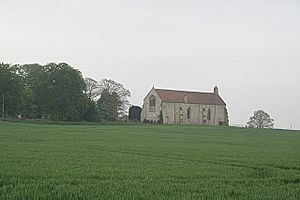Kyme Priory facts for kids
Kyme Priory was an old religious house in South Kyme, Lincolnshire, England. Today, parts of its original buildings are now part of the local church, called Saint Mary and All Saints Church.
The priory was founded by Philip of Kyme before the year 1169. It was built for a group of religious men called Augustinian canons. These canons were like priests who lived together under special rules. About twelve canons lived there, and the priory was dedicated to the Blessed Mary.
Life at Kyme Priory
In 1377, a church leader named Bishop Bokyngham visited the priory. He found that the canons were spending too much time serving churches far away. This meant they weren't living together as a community as much as they should. The Bishop told them to stop serving distant churches. He wanted them to focus more on their prayers and life at the priory.
The Bishop also made other rules. He told the canons they couldn't wear swords or other weapons. Their religious clothes should not be too fancy. They were also told not to leave the priory without permission. They couldn't eat or drink outside the monastery. And they shouldn't entertain friends too much inside the priory.
Later, in 1422, Bishop Flemyng gave similar rules. In 1417, Bishop Repyngdon even ordered a canon to be brought back. This canon had left without permission to join another religious group in Nottingham.
More Rules and Complaints
Another important visit happened in 1440 by Bishop Alnwick. During this visit, the leader of the priory, called the prior, complained. He said his canons liked to play too many idle games.
The person in charge of the food and supplies, called the cellarer, also had complaints. He said there were too many boys in the choir, which made it hard to pray. He also mentioned that the infirmary, a place for sick canons, needed repairs. Some canons were eating in the nearby town of Kyme when they were on business. One canon was even hunting for his own benefit.
Other canons complained that a few people held too many important jobs. They also said that too many regular people were allowed into the choir and dining hall. Bishop Alnwick listened to all these points. He ordered that the canons should spend more time studying and praying. He also said that regular people should not be allowed in the choir or dining hall. And the infirmary had to be fixed.
The Priory's Money and End
In 1534, the priory earned about £101 each year. This money came from churches they owned in several towns. These included Kyme, Swarby, Ewerby, and others.
When the first law to close religious houses was made in 1535, the canons of Kyme Priory really wanted to keep their monastery open. Even though they only made £200 a year, they paid a large fee of £200 every year to stay open.
However, Kyme Priory eventually closed during the time known as the Dissolution of the Monasteries. This was when King Henry VIII closed many monasteries in England. The last leader of the priory was Ralph Fairfax, who became prior in 1511. The priory officially closed on July 6, 1539. After it closed, the land and buildings were given to the Earl of Rutland and Robert Tyrwhitt.
Important People Buried Here
Some notable people were buried at Kyme Priory:
Saint Mary and All Saints Church Today
The Saint Mary and All Saints Church in South Kyme is still standing today. It used to be the south side and part of the main area of the priory church. The church was changed a lot and partly rebuilt in 1805. Today, it is recognized as a Grade II* listed building, which means it's a very important historic building.






